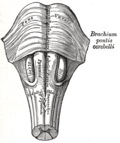Medulla oblongata
Medulla oblongata is a continuation of the spinal cord in the rostral direction and, as its most caudal part, already belongs to the brain. The dividing line between the spinal cord and the spinal cord is the decussatio pyramidum . The boundary between the medulla oblongata and the pons of Varola is the sulcus bulbopontinus , a groove running horizontally at the rostral end of the medulla oblongata. Ventrally, the elongated spinal cord is arched into two parallel, longitudinal mounds - pyramides medullae oblongatae , which contain the white matter of the pyramidal pathway, i.e. tractus corticospinalis . The median anterior fissure runs between them .
Laterally, there are paired elevations, called olives , on the elongated spinal cord . Dorsal to the olive lie the pedunculi cerebellares inferiores . The pedunculi cerebellares are generally thick bundles of white matter through which the pathways run, connecting the stem (in this case the medulla oblongata) to the cerebellum . The pedunculi diverge into a V-shape, and between them is spread the velum medullare inferius , which is a thin plate, an outgrowth of the ependyma . The free end of the vela is followed by the tela choroidea ventriculi quartii , a fibrous plate containing the choroid plexus , which forms the cerebrospinal fluid , here to IV. cerebral ventricles .
Tela choroidea ventriculi IV. it is not whole, it contains several holes. They are apertura median ventriculi quarti (foramen Magendi) and paired aperturae laterales ventriculi quartii (foramina Luschkae). These openings form a communication between the ventricular system and the subarachnoid space of the brain and allow the circulation of cerebrospinal fluid.
The dorsal surface of the elongated spinal cord is also arched into two bumps - tuberculum gracile et tuberculum cuneatum . They contain the nuclei of the same name, which are the end station of the spinal fasciculus gracilis and cuneatus , which lead the main sensitive pathways of the brain. The pathways connect here and continue further into the higher levels of the brain. Through the middle of the oblongata runs the canalis centralis , which opens cranially into the IV. cerebral ventricles. The following cranial nerves depart from the medulla oblongata – IX , X , XI and XII . [1]
Links[edit | edit source]
Related articles[edit | edit source]
References[edit | edit source]
- ↑ ČIHÁK, Radomír. Anatomie. 2. edition. Praha : Grada Publishing, spol. s. r. o., 2004. 673 pp. vol. 3. ISBN 80-247-1132-X.


